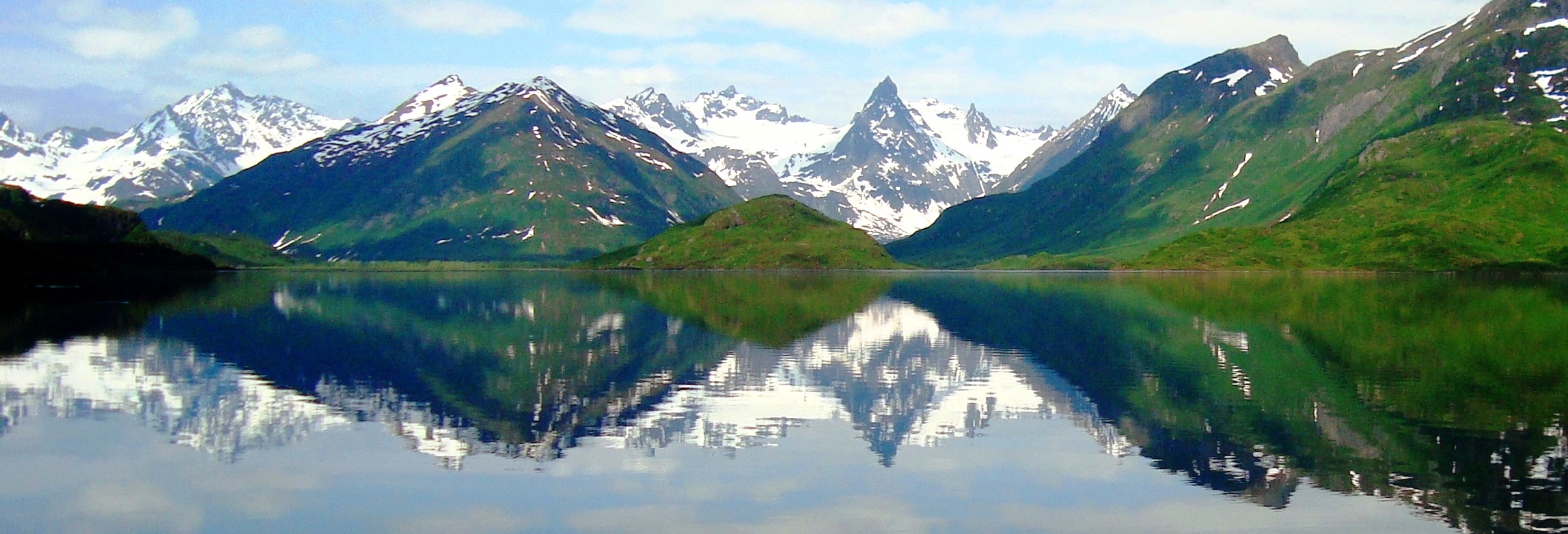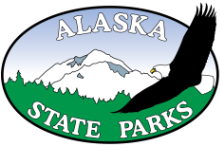Southwest Region
Wood-Tikchik State Park & Lake Aleknagik State Recreation Site
Overview
At nearly 1.6 million acres, Wood-Tikchik State Park is the largest state park in the nation. This one park encompasses nearly half of the State Park land in Alaska and 15 percent of all state park land in the United States. The park's acreage is quite diverse and includes 12 lakes, over 1,000 acres, rivers up to 60 miles in length, mountains exceeding 5,000 feet in elevation, and extensive lowlands.
The Lakes of Wood-Tikchik
Wood-Tikchik State Park is named for its two systems of large interconnected clear-water lakes located in southwest Alaska, just north of Dillingham. The southern lakes, the Wood River system, drains into Bristol Bay via the Wood River. The northern Tikchik Lake system drain into Bristol Bay by the Nuyakuk and Nushagak Rivers.
Wood-Tikchik State Park was created in 1978 for the purposes of protecting the area's fish and wildlife breeding and support systems and to preserve the continued use of the area for subsistence and recreational activities. The land and water in this region are traditional grounds for subsistence fishing, hunting, and gathering. These activities are an integral part of the culture in this region and provide not only food but a cultural tie to the land.
The management philosophy is one of non-development and protection of the area's wilderness character. Park facilities are rustic and few, with great emphasis placed upon low-impact camping and Leave No Trace © practices.
Come visit and enjoy the beauty and splendor of Wood-Tikchik State Park. Camp and picnic on extensive lakeshore beaches, fish a scenic, clear-water stream or paddle a vast and picturesque lake; the possibilities are endless. You can create your own adventure in southwest Alaska!
Wood-Tikchik State Park
P.O. Box 1822
Dillingham, Alaska 99576
907-842-2641
Backcountry Basics
Wood-Tikchik State Park offers a remote wilderness experience. Park visitors should be prepared for emergencies and accident prevention practices are key ingredients to a pleasurable and successful trip. Some tips for a safe adventure include:
File a Trip Plan. Leave it with a friend, your air taxi, State Park office, or someone reliable. Include trip destination, travel routes, timeline, expected return date. Be sure to close the plan when your trip is complete.
Practice Low Impact Camping. Camp on durable surfaces (gravel, rock, sand or snow). Leave a clean camp. Your camp should look as though no one was ever there. Solid human waste should be deposited in a shallow hole 8-12 inches deep at least 100 feet from any water.
Know Your Whereabouts. Use a GPS unit or a topographical map. The use of topographic maps will enhance your appreciation of the park's terrain and help you monitor your location.
Beware of Weather. Always carry warm clothing and quality rain gear. Wind on the open lakes can create dangerous conditions very quickly. Travel close to shore when possible and always wear a life jacket.
Survival Kit and First Aid. Fire starters, a compass, water treatment, and a first aid kit are essential for backcountry travel. Use effective raingear and keep a reliable fire starter on your person.
Fires. Open fires are only permitted on unvegetated gravel
beaches and bars. The use of portable camp stoves is encouraged
and permitted throughout the park.
- Live tree cutting is prohibited.
- Use dead and down wood only.
- Extinguish fires completely.
- Scatter fire rings, unburned wood, and cold ashes.
Avoid bears, but be prepared for bear encounters.
- Keep a clean camp. Don't bury food or trash.
- Avoid camping on salmon streams.
- Store food downwind of camp, at least 100 yards away.
- View bears from a distance.
- Make lots of noise when hiking.
Protect Your Equipment. Bears and porcupines love to chew on
plastic fuel canisters, rafts, and skinned kayaks. Bring a patch kit and
protect them if possible.
Food and Fuel. Weather and other unforeseen variables can
often extend a trip unexpectedly. Carry extra food and fuel, just in
case your adventure lasts longer than planned.
Insects. Mosquitoes and biting flies can diminish an otherwise wonderful trip. At a minimum wear a long sleeved shirt or pack insect repellent and bring a head net.
Giardiasis. Treat water by boiling, filtration or chemical tablets to remove Giardiasis and other parasites.
Respect the Land. Avoid camping or trespassing on private lands. Respect the cultural heritage and subsistence activities of local residents.
Planning Your Trip
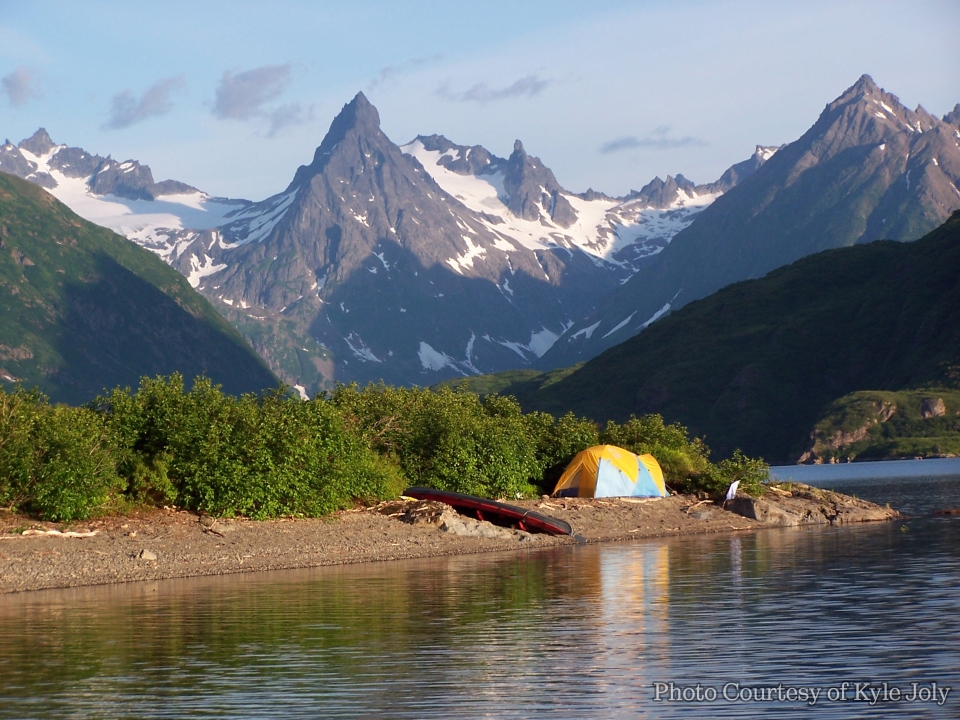
Wood Tikchik State Park is accessible only by boat, airplane or foot and by snowmobiles in the winter when snow conditions allow. Air transportation is often the most practical means of access and several air charter companies are available in the local area. Equipment rental is also available for camping gear, kayaks, canoes, and inflatable rafts.
Low Impact Camping and Wilderness Permits
The entire park is open to camping; however, permits are required to
camp on or around:
- Nishlik Lake
- Slate Lake
- Upnuk Lake
- Chikuminuk Lakes and
- to float the Tikchik River
Camping and float trip permits require a $350 fee, and can be obtained online via Reserve America. Please plan ahead as permits are limited.
Camping at any undeveloped area in the park is limited to 10 days at
one location, after which a camp must be relocated a minimum of one
mile from that location. The Agulukpak River Campground has a three-
night stay limit and commercial use of the campground is prohibited.
Low impact camping techniques are highly encouraged, including using gas stoves for cooking rather than firewood, camping on gravel beaches, and leaving areas with little to no evidence of use. Campfires are restricted to portable camp stoves, fire pans, or unvegetated bars or beaches. Cutting trees is also prohibited, as well as disturbing or removing natural objects.
 Float Trips
Float Trips
Self-guided float trips are an excellent way to see the park. Float the five
Wood River Lakes or the Tikchik River for an unforgettable trip. The
Wood River and Tikchik Lakes occupy deep glacial valleys carved spanning
a variety of terrain, deep fjord-like arms are surrounded by spired peaks
and high alpine valleys and extensive lowlands surround the lakes to the
east.
Private Property
Please respect private property and do not trespass. Native allotments
and private lodges are located in the park. Lodges operate on a
reservation basis and do not cater to drop-in visitation.
Contact the State Park office 907-842-2641 with questions about private
property within the park.
Float Trips
Float |
Miles |
Difficulty |
Days |
Comments |
Wood River Lakes Water Trail |
85+ |
Class I-III |
5+ |
The most popular and accessible float trip within the park. This float passes through five lakes and four shallow clear water rivers. Rangers recommend at least 7-10 days for this journey, or even longer adding time to explore the western reaches of the lakes. The lakes can be very rough with 2-4 foot breaking waves if a strong wind is present. Excellent fishing and wildlife viewing opportunities. |
Tikchik River from Nishlik Lake |
60 |
Class I-II |
4+ |
Permit required. The river is used for floating, fishing, hunting and wildlife viewing. When water levels are low exposed gravel bars are suitable for camping. Excellent hiking, fishing and wildlife viewing opportunities. |
Tikchik River from Upnuk Lake |
42 |
Class I-II |
4+ |
Permit required. Open hills and caribou trails on the upper river provide ample opportunities for day hikes, exploring and hunting. During low water, the river from Upnuk to the confluence flowing from Nishlik Lake can be shallow. |
Nuyakuk River |
54+ |
Class II-IV |
4+ |
Just below the outlet of Tikchik Lake is a class II rapid. Caution is advised. Five miles downstream of the outlet is Nuyakuk River Falls. Portage is recommended. Use the Portage Trail located on river right to hike downstream around the rapids to the beach. Float from Tikchik Lake to one of the villages on the Nushagak River or on to Dillingham. The first 12 miles of Nuyakuk River are in the park. |
Allen River |
10 |
Class III-V+ |
1 |
Permit required to camp on or around Chikuminuk Lake. The Allen River has severe rapids and is rarely run by boaters. The upper and lower rapids are very difficult. It is highly recommended to portage several class V rapids. |
Important Safety Reminders
- Always wear a life jacket
- Always file a float plan
- Dress in layers and pack extra clothes in a waterproof bag.
- Never mix alcohol and boating. Alcohol impairs judgment, slows reaction time, and increases the chance of hypothermia.
- Carry an extra paddle, a first-aid kit and waterproof matches or a lighter.
Floating in Wood-Tikchik State Park offers a remote wilderness experience. Most areas are very isolated and require travelers to be self-sufficient.
Please bring extra food and clothing, a waterproof shelter and a personal locator beacon or satellite phone on your trip.
For more information please visit
https://dnr.alaska.gov/parks/boating/index.htm
Fish and Wildlife of Wood-Tikchik State Park
Wood-Tikchik State Park spans 2,700 square miles of mostly remote wilderness. The park provides critical habitat for fish and wildlife and is a sanctuary for many species. The Wood-Tikchik Lakes provide prime spawning and rearing habitat for sockeye salmon, the most central and essential component of the watershed.
Sport Fishing
All five species of Pacific salmon inhabit and spawn in the Wood River
and Tikchik Systems. Rainbow trout, grayling, lake trout, arctic char,
dolly varden, northern pike, whitefish and burbot thrive throughout
the park as well.
Though sockeye salmon are arguably the most important species
found in the park, most visiting anglers come to Wood-Tikchik State
Park after another equally impressive species, rainbow trout.
Rainbows can be found throughout the park and their migrations are
tied closely with salmon spawning. The Agulowak and Agulukpak, two
shallow and relatively short clear water rivers, inspire Wood-Tikchik's
status as a world-class sport fishery.
Hunting
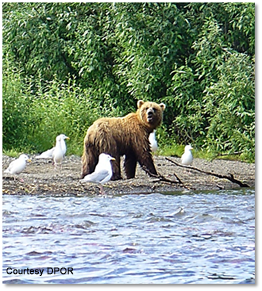 Big game animals including moose, brown and black bear, caribou and wolves can be seen throughout the park. Common small game and furbearers include beaver, marten, otter, fox, wolverine, mink, and porcupine. Sport and subsistence hunting are popular within the park. Primary game species are moose and bear, and some caribou are taken
each year.
Big game animals including moose, brown and black bear, caribou and wolves can be seen throughout the park. Common small game and furbearers include beaver, marten, otter, fox, wolverine, mink, and porcupine. Sport and subsistence hunting are popular within the park. Primary game species are moose and bear, and some caribou are taken
each year.
For information regarding fish and game bag and possession limits, seasons
and methods of take, please refer to the current hunting and fishing regulations
or visit www.adfg.alaska.gov
Subsistence
Subsistence uses in the park are concentrated in and around the lakes and rivers.
Hunting, fishing, and gathering are a vital part of the local way of life. The most
important fish and game resources in the park is salmon, although moose, caribou
and resident fish are also important.
For centuries families have fished for salmon, gathered berries and plants and
hunted for moose and caribou in the Wood-Tikchik and surrounding area. The
park is also used for trapping and providing other renewable resources for food,
clothing, and handicrafts. The culture and the health of the people of the
watershed are reliant on the resources of Wood-Tikchik and the surrounding
lands.
Wood-Tikchik State Park Natural History
Creation of the Park
The high recreational, scenic and natural values of the Wood River and Tikchik Lakes area have long made the area a center of attention. In the early 1960's the National Park Service proposed the area for addition to the National Park System. State selection of the area in 1961-62 and subsequent proposals to create a state park nullified federal designation efforts. In 1961 the Director of the Department of Natural Resources suggested to the Director of the National Park Service that the Wood River-Tikchik Lakes area was of such 'magnificence' as to warrant inter-agency consideration of a plan for utilization of the area.
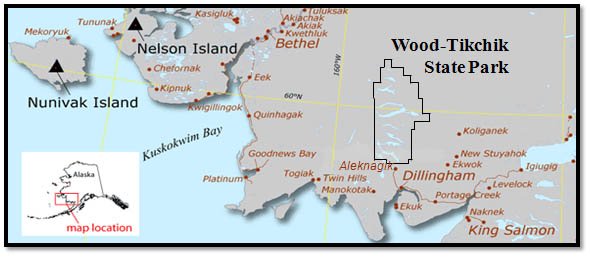
In 1978 the State Legislature designated Wood-Tikchik State Park as part of the Alaska State Park System (AS 41. 21.160). In 1985 southern portions were added by a proclamation of the Governor. In 1986, State Parks entered into a land management agreement with the Aleknagik Natives Limited regarding corporate lands within the park surrounding the Agulowak River. Under the agreement, low-impact public use of corporate lands within the park is allowed in return for park ranger field presence. Lake Aleknagik State Recreation Site offers a gateway to the park. This site was developed through a land exchange in 1996 to provide public access to the lake.
Wilderness Management
Large portions of the Wood-Tikchik State Park are de facto wilderness, experiencing very little visitation and offering few, if any, man-made comforts. Managing the more remote parts of the park for wilderness values is consistent with both legislative direction and local interests, with one major exception: use of motorized vehicles. Conventional wilderness management restricts or prohibits motorized activities, yet the park enabling bill states that park regulations:
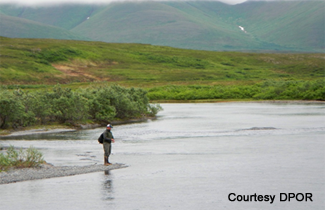 "Shall recognize the current practice of traditional subsistence and recreational activities including the use of small outboard motors and snowmachines. Reasonable access by aircraft for recreational purposes shall be permitted"
"Shall recognize the current practice of traditional subsistence and recreational activities including the use of small outboard motors and snowmachines. Reasonable access by aircraft for recreational purposes shall be permitted"
As set forth in the enabling legislation, a primary purpose in creating Wood-Tikchik State Park was to insure that traditional uses of the area were allowed to continue. While local residents use the park year-round, the park sees its heaviest use between June 15 and the end of September - the prime fishing and hunting seasons.
Traditional Use
Residents of Aleknagik and Dillingham as well as the surrounding villages use the park for a variety of resources. Many residents of these villages are highly dependent on a subsistence lifestyle. The most important fish and game resource within the park is salmon, although moose, caribou and resident fish are also important. The park is also used for gathering firewood, picking berries, trapping and for other renewable resources and food, clothing, shelter, transportation, and handicrafts.

Climate
The climate varies from the humid, maritime influence of Bristol Bay in the south to the cooler, dryer continental influence of the interior to the north. The weather is generally cool and moist with daily high/low temperatures in July averaging 65°F and 46°F, respectively. Precipitation is most prevalent in the summer, occurring about 27% of the time in August along the coast. Total precipitation averages 25 inches annually in Dillingham, with fairly large local variations experienced within the area, due to wide variations in terrain.
Annual snowfall averages 60 to 70 inches at Dillingham and may reach more than 160 inches at Lake Nerka. Winds are usually moderate (0-30 mph), prevailing from the southeast/southwest in summer and from the north and east in winter.
Although the weather from late May to early October permits outdoor recreational activities almost daily; flying, boating, and alpine activities are occasionally hampered or unsafe due to inclement weather. Be prepared to delay your activities until conditions allow for safe travel.
Geology
The Wood-River Tikchik Lake area is split between two physiographic provinces. The western portion of the area lies in the Wood River Mountains. The eastern portion lies in the Nushagak and Bristol Bay lowlands. The Wood River Mountains are steep and rugged with elevations of 2000 to 5000 feet; the lakes and lowlands are between 50 and 500 feet above sea level. The lakes are glacial in origin and are long and deep. The entire area has been extensively glaciated. Surface geology consists predominantly of coarse rubble with bedrock exposures on steep mountain slopes, and moraines and associated drifts at lower elevations.
Flora Wood-Tikchik allows visitors to explore a variety of habitats and a broad diversity of plant life. Lake shores, bogs, open tundra, grassy and alpine meadows, forests, alpine summits and scree slopes provide varying environments for a multitude of plant species to find their niche. Lowland vegetation often includes grasses, sedges, willows, birch, alder, rich wetlands and a variety of vibrant wildflowers.
Wood-Tikchik allows visitors to explore a variety of habitats and a broad diversity of plant life. Lake shores, bogs, open tundra, grassy and alpine meadows, forests, alpine summits and scree slopes provide varying environments for a multitude of plant species to find their niche. Lowland vegetation often includes grasses, sedges, willows, birch, alder, rich wetlands and a variety of vibrant wildflowers.
The forest types and densities found in the park vary extensively. The northern portion of the park is higher in elevation and far from the effects of the sea. Trees are occasional to the north but forests become more widespread and in denser stands in the southern and eastern parts of the park. Forests are generally confine to sheltered and moderately well-drained areas that lie below 1000 feet in elevation.
Permits for Wood-Tikchik State Park
Upper Tikchik Lakes and Tikchik River Permits
Special Use Permits are required to float the Tikchik River or to camp on or around Nishlik, Slate, Upnuk or Chikuminuk Lakes. A flat, non-refundable $350 permit fee + $5 transaction fee is charged per permit.
Permits are now fulfilled via Reserve America.
Upper Tikchik Lakes and Tikchik River Special Park Use Permits
Commercial Park Use Permits
Persons conducting commercial activities within Wood-Tikchik State Park must obtain, in advance, a permit issued by the Division of Parks and Outdoor Recreation per State of Alaska regulations. Examples of Commercial activities include guided activities, outfitting, commercial photography and filming, charter services, transportation services, etc.
Applications may be submitted in person; by mail or via email: parkpermitting@alaska.gov
Once the permitting process is completed, the Commercial Operator will receive the permit and at that time will be authorized to conduct the permitted activity in the park. Commercial Operators are not authorized to operate in the park until the permit has been issued.
All vehicles that operate commercially within the Alaska State Park system must be registered commercially with the Alaska Division of Motor Vehicles. A copy of the registration must be given to the permitting office. A vehicle decal will be issued and is to be permanently affixed to the lower corner of the driver side of the windshield.
Commercial Park Use Permit Information and Application
Special Park Use Permits
Special Use Permits are required for a wide variety of special events, such as those listed below. A special use permit is not required for regular recreation activities.
For a complete list of commercial and non-commercial activity fees, please read the current Director's Order on State Park Fees.
· Groups of 20 or more people.
Example: Company picnic or family reunion.
· Other organized events.
Example: Weddings.
· Conducting scientific research.
Example: Collecting plants for scientific study, collection, or educational purposes.
Included with the Special Use Permit will be a list of standard, general stipulations. Permits may also include additional stipulations customized to your specific situation.
Special Park Use Permit Application
Wood-Tikchik State Park Regulations
The following list of regulations help govern the management of Wood-Tikchik State Park. For a full list of State Park and Wood-Tikchik specific Regulations, please visit the Alaska Statutes and Regulations web page at http://www.legis.state.ak.us/basis/folio.asp
Wood-Tikchik Regulations
11 AAC 20.365 Portions of the Wood-Tikchik State Park Management Plan (2002) are adopted by reference:
1) The park-wide management policy addressing levels of commercial use, as set out in Chapter 7, pages 7-3 and 7-4- DPOR will, in the Director's discretion, establish limits on the number of client days, including the number of passengers flown into the park by permitted air taxi operators.
5) the unit specific management guidelines set out in Chapter 9:
Management Unit 1: Tikchik River
The use of hovercraft on water bodies (and snow and ice covering water bodies) is prohibited on the upper river within the Wilderness Area and is allowed only between January 1- May 31 annually on the lower river in the Natural Area. Management Unit 2: Upper Tikchik Lakes- Nishlik, Slate, Upnuk and Chikuminuk - This unit is designated wilderness.
The use of generators is prohibited.
The use of hovercraft anywhere in this unit is prohibited.
Management Unit 4: Lake Kulik and Grant Lake - This unit is designated Wilderness
The number of persons in a party camping in this management unit is limited to 10.
The use of generators is prohibited.
The use of hovercraft anywhere in this unit is prohibited.
Management Unit 6: Agulukpak River
Between 6 am and 6 pm daily, 25 client days are allowed. Between 6 pm and 6 am daily, an additional 25 client days are allowed. This limit does not apply to unguided users or to guides themselves.
Stays in the campground at the Agulukpak are limited to three nights. Commercial use of the campground is prohibited. Primitive camping is allowed along the river as long as camps are at least one-mile away from the cabin and campsites.
Management Unit 9: Lake Aleknagik State Recreation Site
A person may not operate a motorized boat in excess of "Slow No-Wake" speed, five miles per hour maximum, within 200 feet of a state-managed dock, swimming beach or boat launch within an area designated and marked as "slow no-wake" zone.
11 AAC 20.370 Use of Weapons
The use and discharge of a weapon for the purpose of lawful hunting or trapping is allowed in Wood-Tikchik State Park.
11 AAC 20.375 Aircraft
(a) The use of fixed wing aircraft is allowed in Wood-Tikchik State Park.
(b) A person may not land a helicopter in Wood-Tikchik State Park.
11 AAC 20.380 Power Boats
(a) Except as provided in (b)-(c) of this section, the use of motorized boats is allowed in Wood-Tikchik State Park.
(b) The use of an airboat is prohibited.
(c) The use of a personal watercraft is allowed only on Lake Aleknagik.
(d) The use of hovercraft.
(1) Is allowed between January 1 and May 31 only on water bodies or on snow and ice covering water bodies;
(2) except as authorized by the director under 11 AAC 18.010, is prohibited on Upnuk, Chikuminuk, Grant, Kulik, Nishlik, and
Slate lakes and the upper Tikchik and Wind Rivers.
(e) The use of a motorized boat is prohibited on Lake Chikuminuk.
11 AAC 20.385 Campfires
Open fires are allowed on non-vegetated gravel bars and beaches.
11 AAC 20.390 Snowmobiles
If the director finds that the snow depth is adequate to protect underlying vegetation, the director may open Wood-Tikchik State Park to the use of snowmobiles.
11 AAC 20.397 Public Use Limitations
(a) A person, or at least one person in a party must apply for and obtain a permit issued under 11 AAC 18.010 before engaging in one or more of the following activities:
(1) floating the Tikchik River from either Nishlik or Upnuk lakes;
(2) camping on or around Chikuminuk, Nishlik, Slate, or Upnuk lakes.
(b) A person may not organize or conduct an assembly or party in Management Units 1, 2, or 4 of more than 10 people in Wood-Tikchik State Park.
(Management Unit 1: Tikchik River; Management Unit 2: Upper Tikchik Lakes- Nishlik, Slate, Upnuk, and Chikuminuk; Management Unit 4: Lake Kulik and Grant Lake)
State Park Regulations
11 AAC 12.180 Fires - In a state park, all fires must be in a portable camp stove or confined to a structure provided by the division for fires, or as otherwise provided in 11 AAC 20.
11 AAC 20.983 Use of Aircraft
(a) The use of fixed wing aircraft is allowed in the following state recreation areas, except for the purpose of practice landings:
(1) Blair Lake State Recreation Area;
(2) Tokositna State Recreation Area;
(3) Lake Aleknagik State Recreation Site;
(4) Fielding Lake State Recreation Area;
(5) Lake Louise State Recreation Area.
(b) In the Lake Aleknagik State Recreation Site, a person may not operate an aircraft in excess of "Slow No-wake" speed, five mile per hour maximum, within 200 feet of a state managed dock, swimming beach, or boat launch, or within an area designated and marked as a "Slow No-wake" zone.
(c) A person may not step taxi, take off or land an aircraft within 400 feet of the shore in an area commencing 400 feet east of Mosquito and Moody Points and running west along both shores of Lake Aleknagik State Recreation Site.
Frequently Asked Questions
Visitors and prospective visitors often have numerous question about the park. Below is a list of questions and answers that may assist your trip planning. If your question isn't answered below please contact the park for further information. Many regulations are cited and you can click the link to find further information or a description.
What should I bring? Always carry the ten essentials when visiting the backcountry: extra clothing, extra food, sunglasses, first aid kit, knife, matches, fire starter, light source, map, and compass are daytrip essentials. Additionally, proper shelter, footwear and water or water filtration equipment are recommended in case that day trip turns into an unexpected overnight stay.
When do I need a permit? Permits are required prior to camping on or around Nishlik, Slate, Upnuk or Chikuminuk Lakes, floating the Tikchik River, for any organized assembly of more than 20 people, any entertainment, athletic, or competitive event, any incompatible use, all research involving disturbance or collection of park resources, and for all commercial activities. See the Permits section of this page for more information.
Can I have a fire? Fires are allowed in portable camp stoves, metal fire rings provided by the park and on unvegetated gravel bars and beaches. Practice Leave no Trace camping and scatter cold ashes and all evidence of fire rings after use. 11 AAC 20.385
What about bears? Do I need an electric fence if I camp in the park? Brown bears frequent lakeshores and rivers throughout the park during the summer months. Practice safe camping techniques to minimize conflict with bears. Camp away from inflow streams, and store all food and scented items such as toothpaste well away from camp, hang from a tree if possible. Electric fences may provide additional safety assurance while camping but are rarely used by visitors.
Where can I get firewood? Wood that is both dead and lying on the ground may be gathered for lawful personal use within the park. No wood may be gathered for personal use off of state park land, including for use on private lands within the park. Cutting live trees is prohibited. 11 AAC 12.170
When can I hunt or fish in the park? Hunting and fishing are both allowed in the park. The Alaska Department of Fish and Game provides information on regulations including: lawful seasons, lawful gear and gear and weapon restrictions. Regulation information and licenses are available at Alaska Department of Fish and Game and at local sporting goods stores.
What's the weather like in the park? The weather is generally cool and moist with daily temperatures in July averaging between 46°F to 65°F. Visitors should be prepared for all types of weather.
Can I light off fireworks in the park? The discharge of fireworks is not allowed in the park. They can injure visitors, disturb wildlife and cause wildfires. 11 AAC 12.197
What air charter service should I use? There are a number of commercial air taxi operators permitted to operate in Wood-Tikchik State Park. Many charter companies also provide equipment rental services including: rafts, canoes, kayaks and camping equipment.
How long can I camp? Camping is limited to 10 consecutive days at the same location in a calendar year. After 10 days all equipment must be moved to no less than one mile away. In the developed campground on the Agulukpak River the stay limit is three nights. 11 AAC 20.365
Can I take my firearm in the park? Firearms may be carried in the park but only discharged for self-protection or lawful hunting and trapping. Target practice is prohibited in the park. 11 AAC 20.370
Can I land my airplane or helicopter in the park? The use of fixed wing aircraft is allowed in the park. Helicopter landings are not allowed in the park. 11 AAC 20.375
Are there fees to park? There is a $10 boat launch fee for use of the launch at the Lake Aleknagik State Recreation Site. Fees help maintain our park facilitates. If you are a frequent user you may consider purchasing an annual boat launch pass.
Can I pick berries in the park? Yes, berries and edible plants may be gathered for personal consumption, but not for sale. Collecting, damaging or disturbing rocks, trees, other plants or minerals is prohibited. 11 AAC 12.170
Can I pan for gold? Gold panning is prohibited within Wood-Tikchik State Park. 11 AAC 12.170
Can I take antlers home I found in the park? Antlers and any other part of an animal found within the park should remain untouched. Disturbing or removing these natural items from the park is considered disturbance of natural objects. 11 AAC 12.170.
Where can I snowmobile? Snowmobiles are allowed in the park when snow depth is adequate to protect underlying vegetation. All snowmobiles must be currently registered with the Department of Motor Vehicles before they can be operated in any state park. Backcountry gear and safety equipment is highly recommended for any snowmobile trip in Wood-Tikchik State Park. 11 AAC 20.390
Are there avalanches in the winter? Yes, avalanches are a real hazard and can occur anywhere. Especially susceptible areas include: gullies, steep snow-covered slopes, and anywhere below steep ridges. If you are going to be in the backcountry, an avalanche class will teach you valuable skills to prepare for the hazards of avalanches. Alaska Avalanche School.
Is there giardia in the water? Yes, it is possible that watersheds in the park are contaminated with giardia. It is not advised to drink from any watershed prior to purification. Fortunately purifying water to avoid getting sick is easy; boil water for 2 or more minutes, run it through a filter or use chemical treatments.
Are there any poisonous plants? Yes, there are some poisonous and hazardous berries and plants in the park. Bring a plant and berry identification guide to be certain before harvesting or eating. Wear long sleeves and pants to avoid the irritation caused by Cow Parsnip and Devil's Club.
Additional Information
Park Management
Wood-Tikchik State Park Mileage Chart
General Safety
Wood-Tikchik Land-Use Zoning Fact Sheet
Lake Aleknagik Webcam
Current view of Lake Aleknagik


